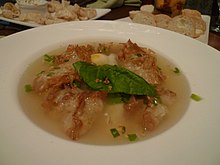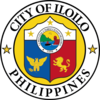Molo, Iloilo City
Molo | |
|---|---|
From top, counter-clockwise: Molo aerial view; Molo Church; Molo Mansion; Molo Plaza bandstand; Convent of Molo | |
| Nickname: Athens of the Philippines | |
 Location within Iloilo City | |
 | |
| Coordinates: 10°41′29″N 122°32′32″E / 10.69139°N 122.54222°E | |
| Country | Philippines |
| Region | Western Visayas (Region VI) |
| Province | Iloilo (geographically only) |
| City | Iloilo City |
| Congressional District | Lone district of Iloilo City |
| Established | 1637 |
| Incorporated (as district) | July 16, 1937 |
| Barangays | 25 (see Barangays) |
| Government | |
| • Mayor | Jerry Treñas (Mayor of Iloilo City) |
| Area | |
• Total | 5.54 km2 (2.14 sq mi) |
| Population (2020 census) | |
• Total | 76,393 |
| • Density | 13,797.44/km2 (35,735.2/sq mi) |
| Demonym | Moleño |
| Time zone | UTC+8 (Philippine Standard Time) |
| ZIP code | 5000 |
| Area code | 33 |
| Patron saint | Saint Anne |
| Feast day | July 26 |
| Native languages | Hiligaynon |
Molo ([ˈmolo]) is a district in Iloilo City, Philippines, located in the province of Iloilo, on the island of Panay in the Western Visayas region. It is the most densely populated district in the city.[1] According to the 2020 census, Molo has a population of 76,393 people, making it the second-most populous district, after Jaro.[2]
Molo is often referred to as the "Athens of the Philippines" due to its association with influential Filipino intellectuals and political leaders. Many renowned Philippine Ilustrados, philosophers, and political figures were born in Molo. The district has produced numerous chief justices, senators, governors, generals, congressmen, and cabinet officials throughout history. It was also known as Parián or Chinatown of Iloilo, where the Chinese residents of the city resided.
Molo is home to Molo Church, a popular centuries-old church located in front of the Molo Plaza. The church is a notable landmark and holds cultural and religious significance. Molo is also known for its local dish, Pancit Molo, a popular pork dumpling soup named after the district where it originated.
Etymology
[edit]The name "Molo" came from the word "moro", the name of the Islamic group called Moro that frequently raided the town. The town's population had a predominance of Chinese, who had difficulty pronouncing the "r" and kept pronouncing molo instead of moro.[3]
History
[edit]
Molo was founded as a Chinese district or Chinatown in 1637. Chinese traders supplying the colonists settled in the area,[4] and it was formally recognized by the Spaniards as Parián. Throughout the 1800s, Molo flourished as a center of learning in the Visayas region, earning the nickname "Athens of the Philippines" for its intellectual and cultural prominence.[5]
In 1896, José Rizal, the national hero of the Philippines, visited Molo on his way to Manila from exile in Dapitan. He was captivated by the beauty of the Molo Church and exclaimed, "La iglesia bonita!" (The beautiful church) in admiration.[6]

During the same period, a group known as the "Conspirators' Committee" or Comite Conspirador was formed in Molo. This committee played a significant role in planning an uprising against the Spanish colonial authorities. In August 1898, the revolution spread throughout Panay Island, with Molo at its forefront. The revolutionaries established a temporary revolutionary government, which became known as the Provisional Government of the District of Visayas.
On July 16, 1937, Molo was incorporated into Iloilo City as a district, alongside the towns of Arevalo, La Paz, and Mandurriao, through Act No. 719 of 1903. This consolidation brought together these distinct areas under the administration of Iloilo City, further contributing to the city's growth and development.[7]
Geography
[edit]Molo is the third-smallest district in Iloilo City, with an area of 5.54 square kilometres (2.14 sq mi). It is 3.21 kilometres (1.99 mi) away from Iloilo City Proper. Molo shares borders with Arevalo to the west, Mandurriao to the north, La Paz to the northeast, and City Proper to the east. The district is the location of the mouth of the Batiano River, which then empties into the Iloilo Strait in the southeast part of the district.
Barangays
[edit]The district of Molo has a total of 25 barangays.
- Calumpang
- Cochero
- Compania
- East Baluarte
- East Timawa
- Habog-Habog Salvacion
- Infante
- Kasingkasing
- Katilingban
- Molo Boulevard
- North Avanceña
- North Baluarte
- North Fundidor
- North San Jose
- Poblacion
- San Antonio
- San Juan
- San Pedro
- South Baluarte
- South Fundidor
- South San Jose
- Taal
- Tap-oc
- West Habog-Habog
- West Timawa
Economy
[edit]The district of Molo is one of the major commercial areas in Iloilo City. It is home to various government agencies, including regional offices of the Department of Social Welfare and Development (DSWD) and the Bureau of Internal Revenue (BIR). These agencies play crucial roles in providing social services and ensuring tax compliance in the region.
Culture and landmarks
[edit]
Molo Church
[edit]The notable Spanish-colonial church and heritage site in the district. It stands in front of Molo Plaza, with prominent red spires that crown its tall bell towers. Molo Church is also known as "the feminist church" because of the all-women's ensemble of saints represented in 16 statues perched on the aisle pillars. The church was declared a national landmark by the National Historical Institute in 1992 through the representation of Sir Knight Rex S. Salvilla. It is the only Gothic church in the country outside of Manila.[8]

Molo Mansion
[edit]The Yusay–Consing Ancestral House, more popularly known as Molo Mansion, stands across the Molo Plaza and Molo Church. Its features are its high ceilings, Neoclassical balustrades, and decorative carvings.[9]
Molo Plaza
[edit]One of the seven district plazas in Iloilo City. Molo Plaza is considered the most beautiful public plaza in the city. The plaza features statues of Greek goddesses and the monument of Maria Clara. A fountain was also installed to break the monotony of the artworks during the rehabilitation in August 2022.[10]
Molo Fiesta
[edit]The annual celebration of the feast of Saint Anne, the patron saint of the district, is celebrated every July 26.

Pancit Molo
[edit]Pancit Molo is a pork dumpling soup. It is a type of soup made with wonton wrappers. It consists of a mixture of ground pork wrapped in molo or wonton wrapper, shredded chicken meat, and also shrimp. Pancit Molo originated in Molo, hence the name.[11]
Education
[edit]
Molo was an educational center dating back to the Spanish colonial period in the Philippines. It was known for having multiple colleges, making it a significant hub of learning at the time. During the Spanish occupation, Molo was home to four colleges: Collegio de Santa Ana, Centro Escolar de Molo, Instituto Ensenanza Libre de Molo, and Escuela Publica. These institutions provided education and academic opportunities for the local population. As a result, Molo has been hailed as the "Athens of the Philippines".
In 1903, Molo became even more notable in the realm of education when Rosendo Mejica, a labor leader and writer, established Baluarte Elementary School. This school holds the distinction of being the first public elementary school established outside of Manila. Today, Mejica's house, which is located in front of the school, serves as a museum, preserving the history and legacy of this educational pioneer.
Currently, Molo continues to be a center of education in Iloilo City. It is home to several educational institutions, including John B. Lacson Foundation Maritime University, Iloilo City Community College, Iloilo Doctors' College, Iloilo Doctors' College of Medicine, and St. Therese – MTC colleges. Additionally, Molo is also home to Iloilo City National High School, one of the most prominent national high schools in the city.
Notable people
[edit]Several known families that come from Molo include - the Locsin, Lacson, Sayson, Pison, Layson, Yusay, among others, some of whom are descended from Chinese immigrants who hispanized, adopted Roman Catholicism, married Filipino or Spanish individuals, and settled in Molo.
Being an educational center during the Spanish occupation in the Philippines and being known as the "Athens of the Philippines", Molo produced many learned men and political leaders, including many chief justices, justices of the Supreme Court, senators, governors, mayors, several generals of the Philippine revolution, and other notable figures. A few of the notable Moleños include:

- Ramon Avanceña, former Chief Justice of the Supreme Court of the Philippines and served as a legal adviser to the Federal State of the Visayas, the revolutionary government of provinces of Iloilo, Capiz and Antique.
- Jhett Tolentino, award-winning Broadway producer.
- Rodolfo T. Ganzon, Filipino politician and a former Senator of the Republic of the Philippines, Congressman of the Second District of Iloilo, Mayor of Iloilo City.[12]
- Jed Patrick Mabilog, former Mayor of Iloilo City.
- Franklin Drilon, Senate Minority Leader and former president of the Senate of the Philippines.
- Gregorio Araneta, former chief justice and Secretary of the Malolos Congress and First Secretary of Justice.
- Raymundo Melliza, former chief justice, general of the Philippine Revolution, and Governor of Iloilo.
- Felicisimo Feria, former chief justice.
- Francisco Villanueva, former senator and Representative of the First District of Iloilo, and as the first senator of the Seventh Senatorial District comprising Iloilo, Capiz and Romblon. He also served as Senate Majority Floor Leader during the Fourth Legislature in 1916-1919.
- Esteban de la Rama, former senator.
- Esperidion Guanco, former senator.
- Jose Ma. Arroyo, former senator and Representative of the First District of Iloilo from 1916 to 1919. He is the grandfather of former first gentleman, Jose Miguel Arroyo, who is the husband of former president Gloria Macapagal Arroyo.
- Francisco Zulueta, former senator.
- Jose C. Zulueta, former orovincial governor of Iloilo and Senator.
- Potenciano Treñas, former senator.
- Amado Avanceña, former governor of Iloilo.
- Gregorio Yulo, former governor of Iloilo.
- Mariano Yulo, former governor of Negros Occidental.
- Jose Yulo-Regalado, former governor of Iloilo.
- Timoteo Consing Sr., former governor of Iloilo.
- Esteban de la Rama, former general of the Philippine Revolution and first commandant of the Philippine Marines.
- Pablo Araneta, former general of the Philippine Revolution.
- Angel Corteza, former General of the Philippine Revolution.
- Aniceto Lacson, former general of the Philippine Revolution and leader of the Negros Revolution.
- Juan Araneta, former general of the Philippine Revolution and leader of the Negros Revolution.
See also
[edit]References
[edit]- ^ "About Iloilo City". Official Website of the Iloilo City Government. Archived from the original on January 21, 2012. Retrieved January 21, 2012.
- ^ Act No. 719 - Act reducing the fifty-one municipalities of the Province of Iloilo to seventeen, Supreme Court E-Library, retrieved December 31, 2019
- ^ "The Ultimate Guide to Molo District in Iloilo City". Iloilo Blogger. July 25, 2021. Retrieved June 12, 2022.
- ^ "Iloilo...My City...My Pride". Archived from the original on January 21, 2012. Retrieved January 21, 2012.
- ^ "Molo: Athens of the Philippines". www.thenewstoday.info. Retrieved May 25, 2022.
- ^ "Molo Church". www.thenewstoday.info.
- ^ Act No. 719 – Act reducing the fifty-one municipalities of the Province of Iloilo to seventeen, Supreme Court E-Library, retrieved December 31, 2019
- ^ "Molo Church: Historical and Religious legacy of Molo". Vigattin Tourism (ARTICLES) - Philippines. Retrieved July 10, 2022.
- ^ "Molo Mansion". Guide to the Philippines. Retrieved August 13, 2022.
- ^ Lena, Perla (June 18, 2022). "Iloilo City opens renovated Molo plaza to public". www.pna.gov.ph. Retrieved August 13, 2022.
- ^ Flores, Wilson Lee. "Iloilo rising: Hometown of pancit molo, Jose Mari Chan & Grace Poe". Philstar.com. Retrieved August 13, 2022.
- ^ "Iloilo City Council honors late Senator Ganzon - IloiloToday - News and Media Blog". Archived from the original on March 20, 2018. Retrieved March 20, 2018.








